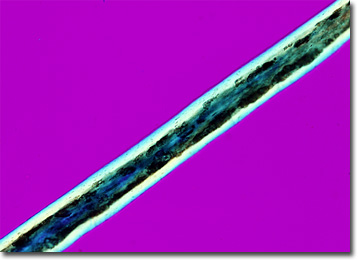Polarized Light Microscopy Digital Image Gallery
Baby Caracul Hair
Sheep, which have been domesticated since at least 5000 BC, are one of the most heavily utilized animals in the world. Not only do they serve as a source of food and milk in various parts of the world, but their wool is used to make cloth and the pelts of lambs are frequently utilized by the fur industry.

View a second image of Baby Caracul Hair
A tremendous variety of sheep breeds have been developed throughout history in order to best meet human demands for the products they provide. The Karakul, which some believe to be the oldest breed of domestic sheep, is of Asian origin and was first introduced to the United States in the early twentieth century. Quite different in appearance than the familiar fluffy white animal that typically comes to mind at mention of the word sheep, adult members of the Karakul breed tend to have black coats, which often fade to gray or brown with age, due to a dominant black gene. The wool sheared from the adults is classified as carpet wool and is used in the fabrication of items such as saddle blankets and rugs. Karakul sheep are, however, primarily raised in order that the pelts of the very young lambs, which are covered in soft, deep black curls, may be obtained. When these pelts come from lambs two weeks to two months old, they are typically referred to as caracul, while the skins of even younger sheep are called Persian lamb or broadtail.
